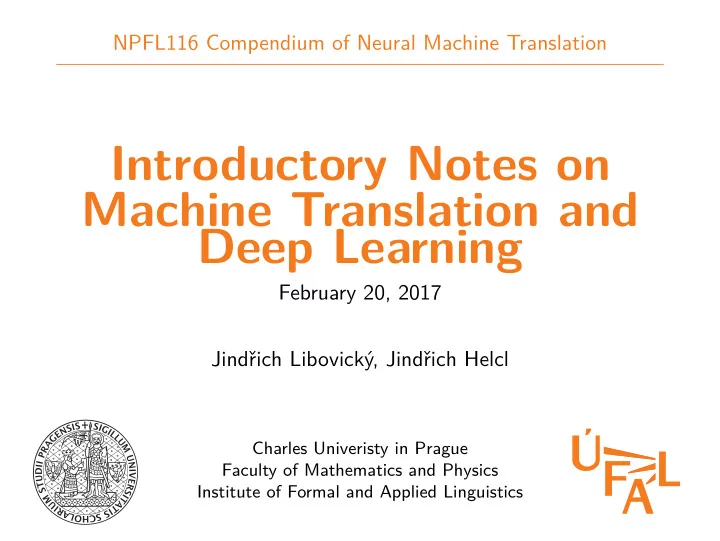

NPFL116 Compendium of Neural Machine Translation Introductory Notes on Machine Translation and Deep Learning February 20, 2017 Jindřich Libovický, Jindřich Helcl Charles Univeristy in Prague Faculty of Mathematics and Physics Institute of Formal and Applied Linguistics
What is machine translation? Time for discussion.
What we think… captured in the data they translate • MT does not care what translation is • we believe people know what translation is and that it is • we evaluate how well we can mimic what humans do when
Deep Learning representation with the increasing level of complexity and abstraction (Goodfellow et al.) raw outputs as parameterizable real-valued functions and finding good parameters for the functions (me) neural networks (backpropaganda, ha, ha) • machine learning that hierarchically infers suitable data • formulating end-to-end relation of a problems’ raw inputs and • industrial/marketing buzzword for machine learning with
Neural Network . . . . . x . . . . . . . . . . . . . ↓ ↓ h 1 = f ( W 1 x + b 1 ) ↓↑ ↓ ↑ h 2 = f ( W 2 h 1 + b 2 ) ↓↑ ↓ ↑ ↓↑ ↓ ↑ h n = f ( W n h n − 1 + b n ) ↓↑ ↓ ↑ ∂ W o = ∂ E ∂ E ∂ o o = g ( W o h n + b o ) ∂ o · ∂ W o ↓ ↓ ↑ ∂ E E = e ( o , t ) → ∂ o
Building Blocks (1) (allows innovations like inventing LSTM cells, ReLU activation) layer-level (allows innovations like batch normalization, dropout) programming concepts (allows innovations like attention) • individual neurons / more complex units like recurrent cells • libraries like Keras, Lasagne, TFSlim conceptualize on • sometimes higher-level conceptualization, similar to functional
Building Blocks (2) Single Neuron 1940’s transforms to input Layer … f nonlinearity, W …weight matrix, b …bias allows using matrix multiplication f ( Wx + b ) • computational model from • having the network in layers • adds weighted inputs and • allows GPU acceleration • vector space interpretations
Encoder & Decoder Encoder: Functional fold (reduce) with function foldl a s xs Decoder: Inverse operation – functional unfold unfoldr a s Source: Colah’s blog ( http://colah.github.io/posts/2015-09-NN-Types-FP/ )
RNNs & Convolutions General RNN: Map with accumulator mapAccumR a s xs Bidirectional RNN: Zip left and right accumulating map zip (mapAccumR a s xs) (mapAccumL a' s' xs) Convolution: Zip neighbors and apply function zipWith a xs (tail xs) Source: Colah’s blog ( http://colah.github.io/posts/2015-09-NN-Types-FP/ )
Optimization • data is constant, treat the network as function of parameters • the differentiable error is function of parameters as well • clever variants of gradient descent algorithm
Deep Learning as Alchemy model – just rules of thumb learned (as in physics), there are only experiments • there no rigorous manual how to develop a good deep learning • we don’t know how to interpret the weights the network has • there is no theory that is able to predict results of experiments
Recoding in mathematics …became planar curves Algebraic equations Image: Existential comics ( http://existentialcomics.com/ ) 100 f(x) 10 x 2 − x − 60 g(x) = 0 h(x) 50 0 . 2 x 3 − 2 x 2 − 10 x + 4 = 0 − 2 x 2 − 10 = 0 0 Y -50 -100 -4 -2 0 2 4 X
Watching Learning Curves Source: Convolutional Neural Networks for Visual Recognition at Stanford University ( http://cs231n.github.io/neural-networks-3/ )
Other Things to Watch During Training (1) • train and validation loss
Other Things to Watch During Training (2) • target metric on training and validation data • L2 and L1 norm of parameters
Other Things to Watch During Training (3) • gradients of the parameters • non-linearities saturation
What’s Strange on Neural MT symbols • we naturally think of translation in terms of manipulating with • neural network represents everything as real-space vectors • ignore pretty much everythng we know about language
Reading for the Next Week LeCun, Yann, Yoshua Bengio, and Geoffrey Hinton. “Deep learning.” Nature 521.7553 (2015): 436. http://pages.cs.wisc.edu/~dyer/cs540/handouts/ deep-learning-nature2015.pdf Question: Can you identify some implicit assumptions the authors make about sentence meaning while talking about NMT? Do you think they are correct? How do the properties that the authors attribute to LSTM networks correspond to your own ideas how should language be computationally processed?
Recommend
More recommend